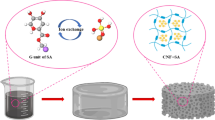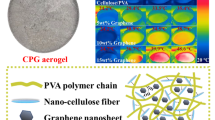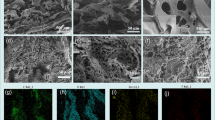Abstract
In this study, a solar evaporation hybrid material including a hydrogel as water transmitter and activated carbon (AC) as solar strong absorber material were prepared for fast evaporation and purification of seawater. We used the polyvinyl alcohol (PVA) polymer as hydrophilic agent and glutaraldehyde (GA) as chemical cross linker for preparation of PVA:GA/AC hydrogel nanocomposite by physical crosslinked freezing/thawing (F-T) process. Structural properties of hydrogel/activated carbon (AC) nanocomposite were characterized by X-ray diffraction (XRD) analysis, surface morphology by field emission scanning electron microscope (FESEM), optical absorption and band gap of components by UV–Vis spectroscopy and chemical bonding by Fourier transform infrared spectroscopy (FTIR). The FESEM images show the capillary and porous structure of the hydrogel for light absorption and hydrophilicity. The results show that solar water evaporation system of the Hydrogel:polyvinyl alcohol (PVA):GA/AC nanocomposite under solar radiation can work continuously to produce clean water with high efficiency, good stability, and high salt removal for water purification applications. The evaporation rate can be up to 2.49 kg h−1m−2 and achieves ultra high purification of seawater and produces clean water. For PVA:GA/AC(NH3) hydrogel, the hardness of seawater decreased from 2580 to 12 ppm and ion conductance from 5489 (μs) to 25 (μs) with evaporation rate = 2.49 (kgm−2h−1). The optical band gap was measured in the range of 1.60 eV–3.10 eV, which indicates the absorption of more wavelengths in the solar spectrum.













Similar content being viewed by others
Data availability
All data generated or analyzed during this study are included in this published article.
References
P.J. Alvarez et al., Emerging opportunities for nanotechnology to enhance water security. Nat. Nanotechnol. 13(8), 634–641 (2018)
J. Xu et al., Solar-driven interfacial desalination for simultaneous freshwater and salt generation. Desalination 484, 114423 (2020)
C. Li et al., Dual-hydrophilic Janus evaporator for long-term and efficient bimode solar evaporation. Chem. Eng. J. 461, 141954 (2023)
Y. Zhao et al., Plasmonic Cu2− x S nanocrystals: optical and structural properties of copper-deficient copper (I) sulfides. J. Am. Chem. Soc. 131(12), 4253–4261 (2009)
M.J. Margeson, M. Dasog, Plasmonic metal nitrides for solar-driven water evaporation. Environ. Sci.: Water Res. Technol. 6(12), 3169–3177 (2020)
I. Ibrahim et al., Semiconductor photothermal materials enabling efficient solar steam generation toward desalination and wastewater treatment. Desalination 500, 114853 (2021)
X. Chen et al., Hierarchical structure regulation for sequential steps in solar vapor generation. EcoMat (2023). https://doi.org/10.1002/eom2.12348
D. Bi et al., Preparation and characterizations of flexible photothermal Ti2O3-PVA nanocomposites. J. Alloys Compds. 825, 153998 (2020)
Y. Ma et al., Highly efficient solar photothermal conversion of graphene-coated conjugated microporous polymers hollow spheres. J. Colloid Interface Sci. 623, 856–869 (2022)
D. Qi et al., Polymeric membranes with selective solution-diffusion for intercepting volatile organic compounds during solar-driven water remediation. Adv. Mater. 32(50), 2004401 (2020)
L. Wang et al., The efficient photothermal performance of organic polymeric material poly3-hexylthiophene for solar driven water evaporation and thermoelectric power generation. J. Solid State Chem. 324, 124081 (2023)
A.M. Ahangar et al., A hydrophilic carbon foam/molybdenum disulfide composite as a self-floating solar evaporator. RSC Adv. 13(3), 2181–2189 (2023)
L. Fu et al., Carbonized waste polyphenylene sulfide non-woven decorated wood evaporator for clean water production from solar photothermal desalination. Desalination 550, 116362 (2023)
W. He et al., Structure development of carbon-based solar-driven water evaporation systems. Sci. Bull. 66(14), 1472–1483 (2021)
P. Zhang et al., A microstructured graphene/poly (N-isopropylacrylamide) membrane for intelligent solar water evaporation. Angew. Chem. Int. Ed. 57(50), 16343–16347 (2018)
C. Chen, Y. Kuang, L. Hu, Challenges and opportunities for solar evaporation. Joule 3(3), 683–718 (2019)
X. Liu et al., Solar thermal utilizations revived by advanced solar evaporation. Curr. Opin. Chem. Eng. 25, 26–34 (2019)
S. Zhang et al., A simple polypyrrole/polyvinylidene fluoride membrane with hydrophobic and self-floating ability for solar water evaporation. Nanomaterials 12(5), 859 (2022)
M. Mohsenpour et al., Preparation and application of sunlight absorbing ultra-black carbon aerogel/graphene oxide membrane for solar steam generation systems. RSC Adv. 10(68), 41780–41790 (2020)
Z. Xie et al., The rise of 2D photothermal materials beyond graphene for clean water production. Adv. Sci. 7(5), 1902236 (2020)
I. Primadona et al., Recent advances and rational design strategies of carbon dots towards highly efficient solar evaporation. Nanoscale 13(16), 7523–7532 (2021)
W. Guan, Y. Guo, G. Yu, Carbon materials for solar water evaporation and desalination. Small 17(48), 2007176 (2021)
M. Yin et al., Facile and low-cost ceramic fiber-based carbon-carbon composite for solar evaporation. Sci. Total. Environ. 759, 143546 (2021)
T. Li et al., Ultra-robust carbon fibers for multi-media purification via solar-evaporation. J. Mater. Chem. A 7(2), 586–593 (2019)
Y. Liu et al., Floatable, self-cleaning, and carbon-black-based superhydrophobic gauze for the solar evaporation enhancement at the air–water interface. ACS Appl. Mater. Interfaces 7(24), 13645–13652 (2015)
Y. Li et al., Solar absorber with tunable porosity to control the water supply velocity to accelerate water evaporation. Desalination 511, 115113 (2021)
L. Zhao et al., A novel floatable composite hydrogel for solar evaporation enhancement. Environ. Sci.: Water Res. Technol. 6(1), 221–230 (2020)
Y. Guo et al., Tailoring nanoscale surface topography of hydrogel for efficient solar vapor generation. Nano Lett. 19(4), 2530–2536 (2019)
L. Zhao et al., Boosting solar-powered interfacial water evaporation by architecting 3D interconnected polymetric network in CNT cellular structure. Chem. Eng. J. 451, 138676 (2023)
J. Zhou et al., Highly efficient and long-term stable solar-driven water purification through a rechargeable hydrogel evaporator. Desalination 537, 115872 (2022)
J. Yuan, E. Passeport, R. Hofmann, Understanding adsorption and biodegradation in granular activated carbon for drinking water treatment: a critical review. Water Res. 210, 118026 (2022)
J. Xu et al., Preparation and characterization of activated carbon from reedy grass leaves by chemical activation with H3PO4. Appl. Surf. Sci. 320, 674–680 (2014)
M. Danish, T. Ahmad, A review on utilization of wood biomass as a sustainable precursor for activated carbon production and application. Renew. Sustain. Energy Rev. 87, 1–21 (2018)
Z. Xu et al., Understanding reactions and pore-forming mechanisms between waste cotton woven and FeCl3 during the synthesis of magnetic activated carbon. Chemosphere 241, 125120 (2020)
J. Li et al., Ultrahigh solar vapor evaporation rate of super-hydrophilic aerogel by introducing environmental energy and convective flow. Chem. Eng. J. 466, 143281 (2023)
L. Li et al., A highly efficient and durable solar evaporator based on hierarchical ion-selective nanostructures. EcoMat 5(2), e12289 (2023)
S. Mao et al., A cryogel solar vapor generator with rapid water replenishment and high intermediate water content for seawater desalination. J. Mater. Chem. A 11(2), 858–867 (2023)
X. Liang et al., A robust PVA/C/sponge composite hydrogel with improved photothermal interfacial evaporation rate inspired by the chimney effect. Desalination 531, 115720 (2022)
C. Ashish et al., Experimental evaluation on the capillarity effect of different wicking structure incorporated in a patterned absorber facilitating solar interfacial evaporation. J. Therm. Anal. Calorim. 147(17), 9865–9886 (2022)
H. Xu et al., Nanoporous activated carbon derived from rice husk for high performance supercapacitor. J. Nanomater. 2014, 229–229 (2015)
C.-M. Tang, Y.-H. Tian, S.-H. Hsu, Poly (vinyl alcohol) nanocomposites reinforced with bamboo charcoal nanoparticles: Mineralization behavior and characterization. Materials 8(8), 4895–4911 (2015)
T. Chen et al., Highly anisotropic corncob as an efficient solar steam-generation device with heat localization and rapid water transportation. ACS Appl. Mater. Interfaces 12(45), 50397–50405 (2020)
Y. Guo et al., Biomass-derived hybrid hydrogel evaporators for cost-effective solar water purification. Adv. Mater. 32(11), 1907061 (2020)
H.M. Wilson, H.W. Lim, S.J. Lee, Highly efficient and salt-rejecting poly (vinyl alcohol) hydrogels with excellent mechanical strength for solar desalination. ACS Appl. Mater. Interfaces 14(42), 47800–47809 (2022)
A.P. Chauhan, K. Chawla, Comparative studies on Graphite and Carbon Black powders, and their dispersions. J. Mol. Liq. 221, 292–297 (2016)
P.-P. Sun et al., A new carbon phase with direct bandgap and high carrier mobility as electron transport material for perovskite solar cells. npj Comput. Mater. 5(1), 9 (2019)
X. Wu et al., Preparation of PVA-GO composite hydrogel and effect of ionic coordination on its properties. Mater. Res. Exp. 6(7), 075306 (2019)
H.S. Mansur et al., FTIR spectroscopy characterization of poly (vinyl alcohol) hydrogel with different hydrolysis degree and chemically crosslinked with glutaraldehyde. Mater. Sci. Eng. C 28(4), 539–548 (2008)
Q. Zhang et al., Improving seawater desalination efficiency by solar driven interfacial evaporation based on biochar evaporator of Nannochloropsis oculata residue. J. Environ. Chem. Eng. 9(4), 105787 (2021)
S. Shahcheragh, M. Bagheri Mohagheghi, A. Shirpay, Study of structural, optical properties and energy band gap of porous activated carbon nanostructures investigation of the effect of chemical activation agents. Opt. Quantum Electron. 55(14), 1256 (2023)
Funding
The authors have not disclosed any funding.
Author information
Authors and Affiliations
Contributions
All authors contributed to the study conception and design. Material preparation, data collection, and analysis were performed by M. Fargharazi, M. M. Bagheri—Mohagheghi. The first draft of the manuscript was written by M. Fargharazi and all authors commented on previous versions of the manuscript. All authors read and approved the final manuscript.
Corresponding author
Ethics declarations
Conflict of interest
The authors declare no conflict of interests.
Additional information
Publisher's Note
Springer Nature remains neutral with regard to jurisdictional claims in published maps and institutional affiliations.
Rights and permissions
Springer Nature or its licensor (e.g. a society or other partner) holds exclusive rights to this article under a publishing agreement with the author(s) or other rightsholder(s); author self-archiving of the accepted manuscript version of this article is solely governed by the terms of such publishing agreement and applicable law.
About this article
Cite this article
Fargharazi, M., Bagheri-Mohagheghi, M.M. PVA:GA polymer hydrogel/activated carbon (AC) nanocomposite as solar photothermal materials: study of structural, optical absorption and water purification properties. J Mater Sci: Mater Electron 35, 449 (2024). https://doi.org/10.1007/s10854-024-12265-5
Received:
Accepted:
Published:
DOI: https://doi.org/10.1007/s10854-024-12265-5




